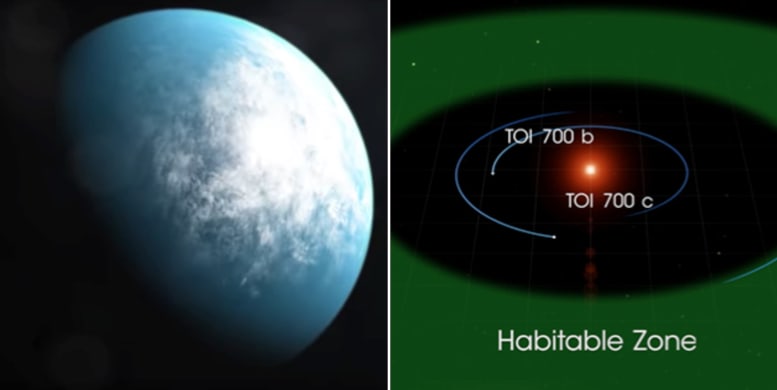
Ny jordliknande planet har hittats – kan vara beboelig
Den amerikanska rymdorganisationen Nasa har hittat en planet som på flera sätt har likheter med vår planet och som har förutsättningar att vara beboelig, rapporterar CNN.
Exoplaneten ”TOI 700 d” har till exempel ett avstånd till sin egen stjärna ”TOI 700” vilket ger bra möjligheter för att det skulle kunna finnas vatten på planetens yta.
Emily Gilbert, student vid University of Chicago, har studerat data från planeten och säger att man under 11 månaders observationer inte kunnat se några soleruptioner från stjärnan.
Planeten är omkring 20 procent större än jorden och ligger ”bara” 100 ljusår härifrån.
bakgrund
Exoplanet
Wikipedia (en)
An exoplanet or extrasolar planet is a planet outside the Solar System. The first possible evidence of an exoplanet was noted in 1917, but was not recognized as such. The first confirmation of detection occurred in 1992. This was followed by the confirmation of a different planet, originally detected in 1988. As of 1 January 2020, there are 4,160 confirmed exoplanets in 3,090 systems, with 676 systems having more than one planet.There are many methods of detecting exoplanets. Transit photometry and Doppler spectroscopy have found the most, but these methods suffer from a clear observational bias favoring the detection of planets near the star; thus, 85% of the exoplanets detected are inside the tidal locking zone. In several cases, multiple planets have been observed around a star. About 1 in 5 Sun-like stars have an "Earth-sized" planet in the habitable zone. Assuming there are 200 billion stars in the Milky Way, it can be hypothesized that there are 11 billion potentially habitable Earth-sized planets in the Milky Way, rising to 40 billion if planets orbiting the numerous red dwarfs are included.The least massive planet known is Draugr (also known as PSR B1257+12 A or PSR B1257+12 b), which is about twice the mass of the Moon. The most massive planet listed on the NASA Exoplanet Archive is HR 2562 b, about 30 times the mass of Jupiter, although according to some definitions of a planet (based on the nuclear fusion of deuterium), it is too massive to be a planet and may be a brown dwarf instead. Known orbital times for exoplanets vary from a few hours (for those closest to their star) to thousands of years. Some exoplanets are so far away from the star that it is difficult to tell whether they are gravitationally bound to it. Almost all of the planets detected so far are within the Milky Way. There is evidence that extragalactic planets, exoplanets farther away in galaxies beyond the local Milky Way galaxy, may exist. The nearest exoplanet is Proxima Centauri b, located 4.2 light-years (1.3 parsecs) from Earth and orbiting Proxima Centauri, the closest star to the Sun.The discovery of exoplanets has intensified interest in the search for extraterrestrial life. There is special interest in planets that orbit in a star's habitable zone, where it is possible for liquid water, a prerequisite for life on Earth, to exist on the surface. The study of planetary habitability also considers a wide range of other factors in determining the suitability of a planet for hosting life.Rogue planets do not orbit any star. Such objects are considered as a separate category of planet, especially if they are gas giants, which are often counted as sub-brown dwarfs. The rogue planets in the Milky Way possibly number in the billions or more.
Omni är politiskt obundna och oberoende. Vi strävar efter att ge fler perspektiv på nyheterna. Har du frågor eller synpunkter kring vår rapportering? Kontakta redaktionen